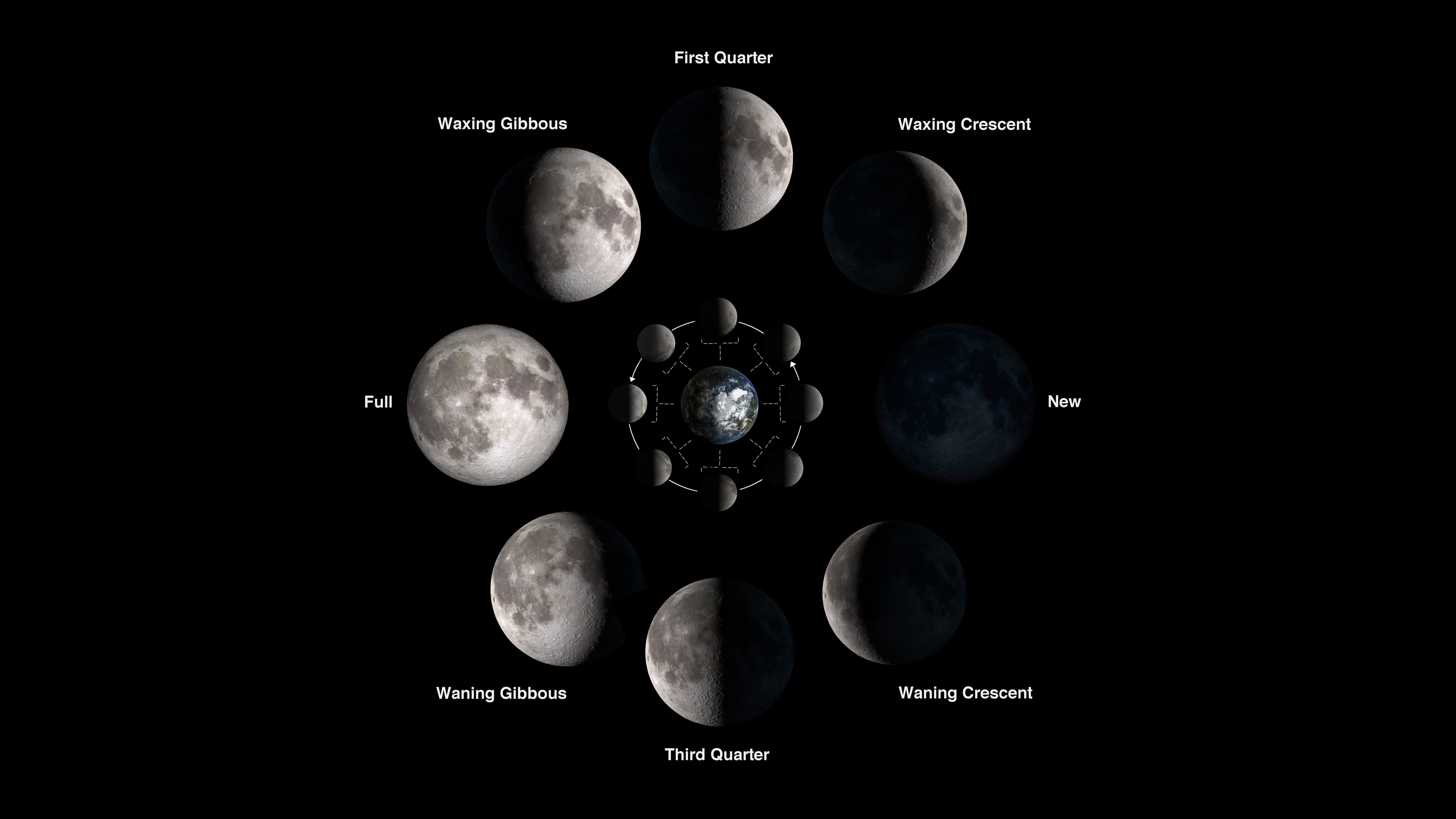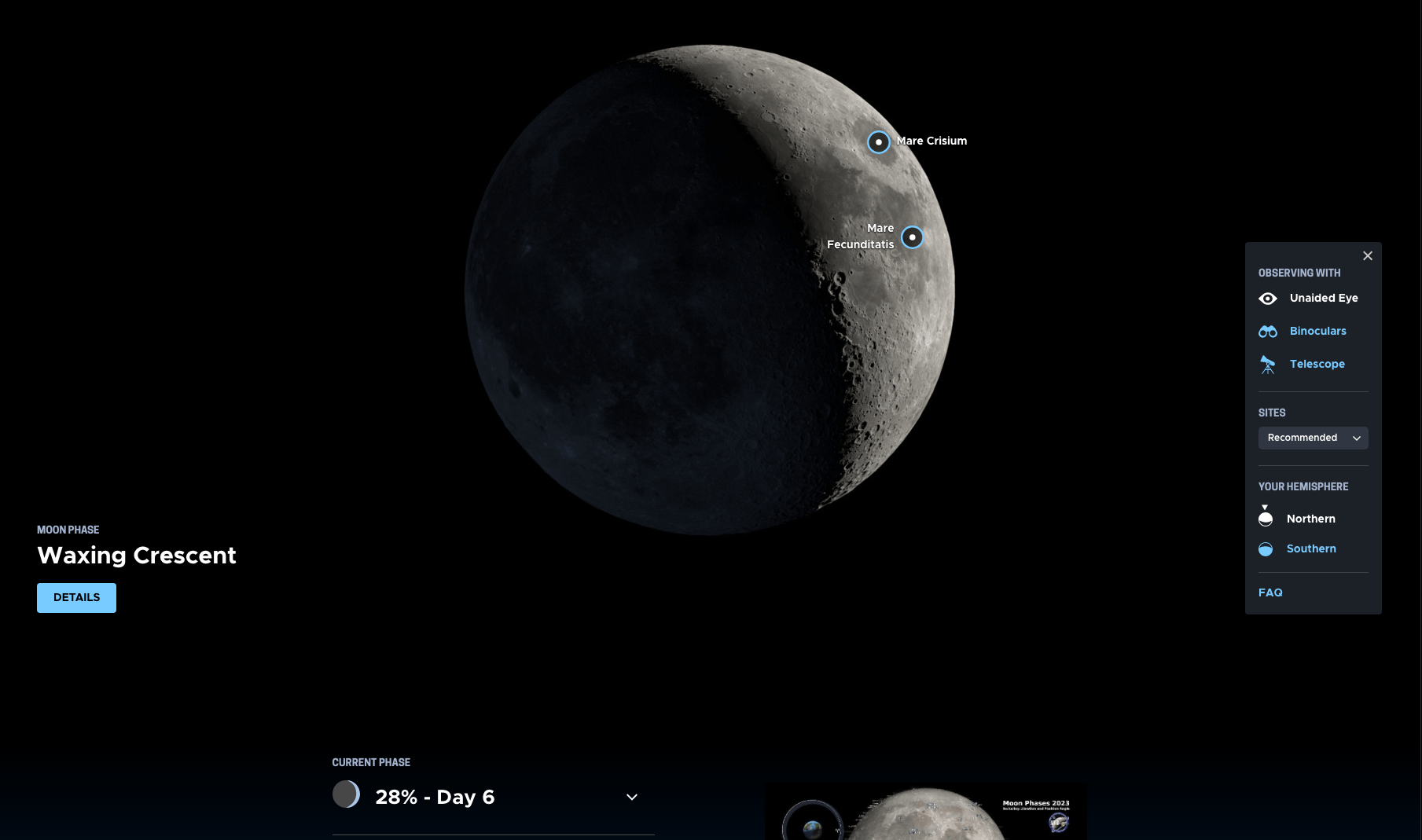Lunar Phases and Eclipses
We always see the same side of the Moon, because as Earth's natural satellite revolves around our planet, the Moon rotates, causing the same side to always face us. And yet, the Moon looks a little different every night. Sometimes the entire face glows brightly. Sometimes we only see a thin crescent. Other times the Moon seems to disappear entirely. Why does the Moon's appearance change?
The moonlight we see on Earth is sunlight reflected off the Moon's grayish-white surface. The amount of Moon we see illuminated changes over the month — lunar phases — because the Moon orbits Earth and Earth orbits the Sun. Everything is moving.
What Are Lunar Phases?
Our Moon doesn't shine, it reflects sunlight. Just as it does in the daytime on Earth, sunlight illuminates the Moon's surface too. That is, the Moon has a day side and also a night side. And as the Moon orbits Earth each month, we do not have a continuous view of the entire side of the Moon that's facing the Sun. Most of the time, our view of the Moon looks toward part of the sunlit side and part of the dark side at the same time.

When sunlight is illuminating only the Moon's far side – the side we can't directly see from Earth – that phase is called a new moon. When sunlight illuminates only the Moon's near side – the side that always faces Earth – we call that a full moon.
The rest of the month, we see a different amount of the daytime side of the Moon each day. These continually changing views of the sunlit part of the Moon are the Moon's phases. The eight lunar phases are, in order: new moon, waxing crescent, first quarter, waxing gibbous, full moon, waning gibbous, third quarter and waning crescent. The cycle repeats once a month (every 29.5 days).
Daily Moon Guide
Check out NASA's interactive map for observing the Moon each day of the year.
Go to the guide
What is a Lunar Eclipse?
During a lunar eclipse, Earth comes between the Sun and the Moon, blocking the sunlight falling on the Moon.
There are two kinds of lunar eclipses:
- A total lunar eclipse occurs when the Moon and Sun are on opposite sides of Earth.
- A partial lunar eclipse happens when only part of Earth's shadow covers the Moon.
During some stages of a lunar eclipse, the Moon can appear reddish. This is because the only remaining sunlight reaching the Moon at that point is from around the edges of the Earth, as seen from the Moon's surface. From there, an observer during an eclipse would see all Earth's sunrises and sunsets at once.

Understanding Lunar Eclipses
A lunar eclipse occurs when the Moon passes through the Earth's shadow, just as a solar eclipse occurs when part of the Earth passes through the Moon's shadow.
So why don't eclipses happen twice a month? The reason is that the Moon's orbit around the Earth is tilted relative to the Earth's orbit around the Sun. But if that's the case, why do eclipses happen at all? Throughout the year, the Moon's orbital tilt remains fixed with respect to the stars, meaning that it changes with respect to the Sun. About twice a year, this puts the Moon in just the right position to pass through the Earth's shadow, causing a lunar eclipse.
As the Moon passes into the central part of the Earth's shadow, called the umbra, it darkens dramatically. Once it's entirely within the umbra, the Moon appears a dim red due to sunlight scattered through the Earth's atmosphere.
In fact, if you watched the eclipse from the surface of the Moon, you'd see the Sun set behind the entire Earth, bathing you in a warm red glow. Back home, you'll have to stay up late to watch a lunar eclipse, but if you do you'll see the Moon in rare form, and you'll catch a brief glimpse of our own planet's long shadow.
Photograph the Moon
Capturing the Moon with a camera is one of the most satisfying—and challenging—projects available to an outdoor photographer. Here are 10 suggestions for making the most of a moonlit night with your camera.
How do Lunar Eclipses Affect Spacecraft?
Lunar eclipses can be a science boon and engineering challenge for orbiting spacecraft, such as NASA's Lunar Reconnaissance Orbiter. The solar-powered orbiter also falls in Earth's shadow, cutting it off from the source of its power. Mission controllers shut down most instruments to conserve energy.
The team leaves on one instrument—called Diviner—that can watch how the lunar surface responds to the rapid change in temperature caused by a lunar eclipse. The data helps scientists better understand the composition and properties of the surface.
Eclipse Videos
Eclipse Activities
- How to watch an eclipse and get students observing the Moon
- Evaluating a Lunar Eclipse (Grades 3-12) - Students use the Danjon Scale of Lunar Eclipse Brightness to illustrate the range of colors and brightness the Moon can take on during a total lunar eclipse.
- Observing the Moon (Grades K-6) - Students identify the Moon’s location in the sky and record their observations in a journal over the course of the Moon-phase cycle.
- Moon Phases (Grades 1-6) - Students learn about the phases of the Moon by acting them out. In 30 minutes, they will act out one complete, 30-day, Moon cycle.
- Measuring the Supermoon (Grades 5-12) - Students take measurements of the Moon during its full phase over multiple Moon cycles to compare and contrast results.
- Modeling the Earth-Moon System (Grades 6-8) – Students learn about scale models and distance by creating a classroom-size Earth-Moon system.
- Make a Moon Phases Calendar and Calculator – Like a decoder wheel for the Moon, this calendar will show you where and when to see the Moon and every Moon phase throughout the year!




